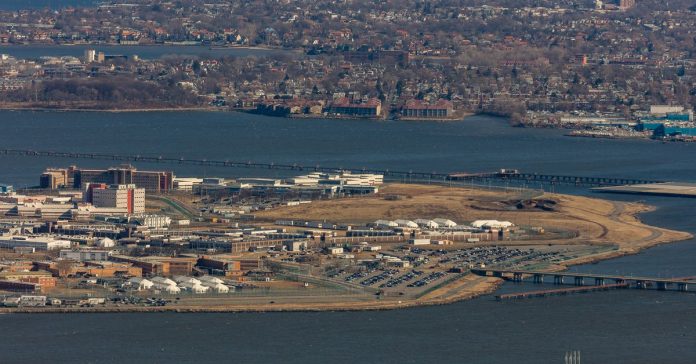The city’s plan to close Rikers Island and move those incarcerated there into four borough-based jails is gearing up to move into its next phase. As part of the years-long process of closing the scandal-plagued prison, the Department of Corrections (DOC) and the Mayor’s Office of Criminal Justice (MOCJ) must go through the city’s uniform land use review procedure (ULURP).
The agencies are hoping to kick off that process next week, and have released a draft environmental impact statement (EIS) that lays out the plan for shutting down Rikers and moving its population into smaller jails in the Bronx, Brooklyn, Manhattan, and Queens.
Some of the particulars of the plan have changed since it was first unveiled in August of last year. The biggest change, and one that was previously reported, is that the Manhattan jail will be located on the site of the borough’s detention complex at 125 White Street, rather in a new location on Centre Street. The EIS proposes a 450-foot building with beds for approximately 1,430 people.
The addresses for the other three facilities will remain the same, and will also each hold around 1,430 people: They’ll be located at 320 Concord Avenue in Port Morris, an NYPD tow pound lot where an entirely new facility would be built; 275 Atlantic Avenue in Boerum Hill, already the site of the Brooklyn House of Detention; and 126-02 82nd Avenue in Kew Gardens, home to the Queens branch of the Family Justice Center. In order to reduce the sizes of these facilities, the number of incarcerated individuals they will hold has shrunk slightly, from 6,000 to 5,750.
These changes reflect the recommendations of the Independent Commission on New York City Criminal Justice and Incarceration Reform, the group studying reform and whose input has informed the move to close Rikers. Its most recent report, issued in December, recommended the city seek out other ways to design smaller jails that fit better within the context of their surroundings.
Judge Jonathan Lippman, the chair of that group, called the release of the draft EIS and the imminent commencement of ULURP a “critical turning point” in the city’s push to close Rikers. In a statement, he also expressed hope that “further adjustments can be made to reduce the size and scope of the jail facilities so that they better integrate with their respective communities.”
“The next seven months will undoubtedly be challenging, but amid these land use discussions, we must not lose sight of the moral imperative of closing Rikers,” his statement reads. “We all bear responsibility for allowing thousands of New Yorkers every year – many of whom are ultimately never convicted of a crime – languish on a violent penal colony. Now is the moment that we must finally turn the page on this dark chapter.”
But even with the modifications, the plan is likely to face significant pushback. In the Bronx, Borough President Ruben Diaz Jr. is a vocal opponent of the location the city has chosen, and along with local officials and other community stakeholders, has proposed an alternate site closer to the Bronx County Family Court building on 161st Street near Grand Concourse.
The site they have chosen in Mott Haven is at least 30 minutes away from the Bronx Hall of Justice by public transportation, with transfers. You can’t even make a direct trip between the two. How does this bring court facilities closer together? (3/3) pic.twitter.com/5clFY6Uk0N
— Ruben Diaz Jr. (@rubendiazjr) March 22, 2019
Residents of other neighborhoods that will be affected by the borough-based jails have previously come out against the plan, with vocal critics from Chinatowntown to Boerum Hill.
Once the city’s ULURP application is certified, there will be multiple steps before the final City Council approval of the plan, including community board meetings and a hearing at the City Planning Commission. If all goes according to plan, the city says construction on the new facilities would begin, at the earliest, by 2021.





































